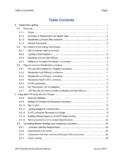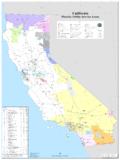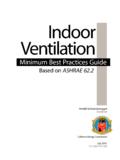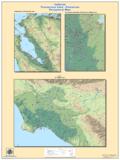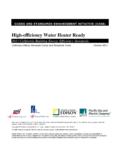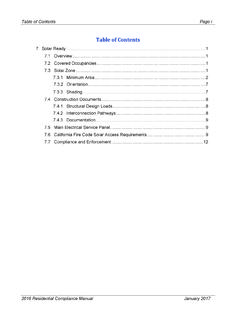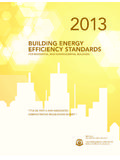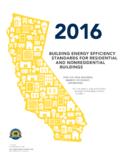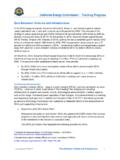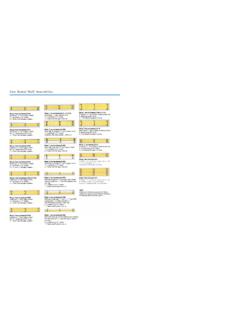Transcription of 2019 Low-Rise Mandatory Measures Summary
1 2019 Low-Rise Residential Mandatory Measures Summary NOTE: Low-Rise residential buildings subject to the Energy Standards must comply with all applicable Mandatory Measures , regardless of the compliance approach used. Review the respective section for more information. *Exceptions may apply. (01/2020) Building Envelope Measures : (a)1: Air Leakage. Manufactured fenestration, exterior doors, and exterior pet doors must limit air leakage to CFM per square foot or less when tested per NFRC-400, ASTM E283 or AAMA/WDMA/CSA 101 * (a)5: Labeling. Fenestration products and exterior doors must have a label meeting the requirements of 10-111(a). (b): Field fabricated exterior doors and fenestration products must use U-factors and solar heat gain coefficient (SHGC) values from Tables , , or for exterior doors.
2 They must be caulked and/or weather-stripped.* : Air Leakage. All joints, penetrations, and other openings in the building envelope that are potential sources of air leakage must be caulked, gasketed, or weather stripped. (a): Insulation Certification by Manufacturers. Insulation must be certified by the Department of Consumer Affairs, Bureau of Household Goods and Services (BHGS). (g): Insulation Requirements for Heated Slab Floors. Heated slab floors must be insulated per the requirements of (g). (i): Roofing Products Solar Reflectance and Thermal Emittance. The thermal emittance and aged solar reflectance values of the roofing material must meet the requirements of (i) and be labeled per 10-113 when the installation of a cool roof is specified on the CF1R.
3 (j): Radiant Barrier. When required, radiant barriers must have an emittance of or less and be certified to the Department of Consumer Affairs. (a): Ceiling and Rafter Roof Insulation. Minimum R-22 insulation in wood-frame ceiling; or the weighted average U-factor must not exceed Minimum R-19 or weighted average U-factor of or less in a rafter roof alteration. Attic access doors must have permanently attached insulation using adhesive or mechanical fasteners. The attic access must be gasketed to prevent air leakage. Insulation must be installed in direct contact with a continuous roof or ceiling which is sealed to limit infiltration and exfiltration as specified in , including but not limited to placing insulation either above or below the roof deck or on top of a drywall ceiling.
4 * (b): Loose-fill Insulation. Loose fill insulation must meet the manufacturer s required density for the labeled R-value. (c): Wall Insulation. Minimum R-13 insulation in 2x4 inch wood framing wall or have a U-factor of or less, or R-20 in 2x6 inch wood framing or have a U-factor of or less. Opaque non-framed assemblies must have an overall assembly U-factor not exceeding Masonry walls must meet Tables or B.* (d): Raised-floor Insulation. Minimum R-19 insulation in raised wood framed floor or maximum U-factor.* (f): Slab Edge Insulation. Slab edge insulation must meet all of the following: have a water absorption rate, for the insulation material alone without facings, no greater than percent; have a water vapor permeance no greater than perm per inch; be protected from physical damage and UV light deterioration; and, when installed as part of a heated slab floor, meet the requirements of (g).
5 (g)1: Vapor Retarder. In climate zones 1 through 16, the earth floor of unvented crawl space must be covered with a Class I or Class II vapor retarder. This requirement also applies to controlled ventilation crawl space for buildings complying with the exception to (d). (g)2: Vapor Retarder. In climate zones 14 and 16, a Class I or Class II vapor retarder must be installed on the conditioned space side of all insulation in all exterior walls, vented attics, and unvented attics with air-permeable insulation. (q): Fenestration Products. Fenestration, including skylights, separating conditioned space from unconditioned space or outdoors must have a maximum U-factor of ; or the weighted average U-factor of all fenestration must not exceed * Fireplaces, Decorative Gas Appliances, and Gas Log Measures : (e) Pilot Light.
6 C ontinuously burning pilot lights are not allowed for indoor and outdoor fireplaces. (e)1: Closable Doors. Masonry or factory-built fireplaces must have a closable metal or glass door covering the entire opening of the firebox. (e)2: Combustion Intake. Masonry or factory-built fireplaces must have a combustion outside air intake, which is at least six square inches in area and is equipped with a readily accessible, operable, and tight-fitting damper or combustion-air control device.* (e)3: Flue Damper. Masonry or factory-built fireplaces must have a flue damper with a readily accessible control.* Space Conditioning, Water Heating, and Plumbing System Measures : : Certification.
7 Heating, ventilation and air conditioning ( hvac ) equipment, water heaters, showerheads, faucets, and all other regulated appliances must be certified by the manufacturer to the California Energy Commission.* (a): hvac Efficiency. Equipment must meet the applicable efficiency requirements in Table through Table * (b): Controls for Heat Pumps with Supplementary Electric Resistance Heaters. Heat pumps with supplementary electric resistance heaters must have controls that prevent supplementary heater operation when the heating load can be met by the heat pump alone; and in which the cut-on temperature for compression heating is higher than the cut-on temperature for supplementary heating, and the cut-off temperature for compression heating is higher than the cut-off temperature for supplementary heating.
8 * (c): Thermostats. All heating or cooling systems not controlled by a central energy management control system (EMCS) must have a setback thermostat.* (c)4: Water Heating Recirculation Loops Serving Multiple Dwelling Units. Water heating recirculation loops serving multiple dwelling units must meet the air release valve, backflow prevention, pump priming, pump isolation valve, and recirculation loop connection requirements of (c)4. (c)6: Isolation Valves. Instantaneous water heaters with an input rating greater than kBtu per hour (2 kW) must have isolation valves with hose bibbs or other fittings on both cold and hot water lines to allow for flushing the water heater when the valves are closed.
9 : Pilot Lights. Continuously burning pilot lights are prohibited for natural gas: fan-type central furnaces; household cooking appliances (except appliances without an electrical supply voltage connection with pilot lights that consume less than 150 Btu per h our ); and pool and spa heaters.* (h)1: Building Cooling and Heating Loads. Heating and/or cooling loads are calculated in accordance with the ASHRAE Handbook, Equipment Volume, Applications Volume, and Fundamentals Volume; the SMACNA Residential Comfort System Installation Standards Manual; or the ACCA Manual J using design conditions specified in (h)2. 2019 Low-Rise Residential Mandatory Measures Summary (h)3A: Clearances.
10 Air conditioner and heat pump outdoor condensing units must have a clearance of at least five feet from the outlet of any dryer t (h)3B: Liquid Line Drier. Air conditioners and heat pump systems must be equipped with liquid line filter driers if required, as specified by the manufacturer s instructions. (j)1: Storage Tank Insulation. Unfired hot water tanks, such as storage tanks and backup storage tanks for solar water-heating systems, must have a minimum of R- 12 external insulation or R-16 internal insulation where the internal insulation R-value is indicated on the exterior of the tank. (j)2A: Water Piping, Solar Water-heating System Piping, and Space Conditioning System Line Insulation.
